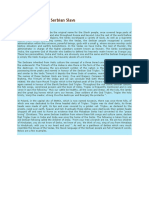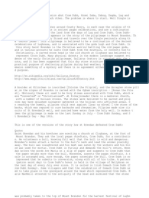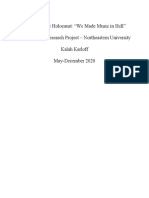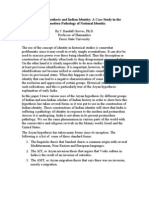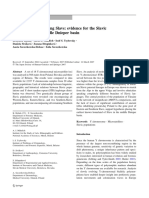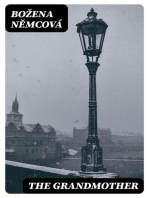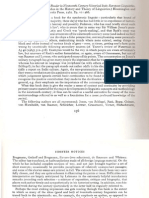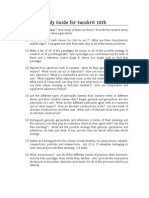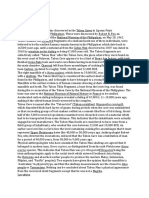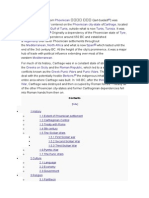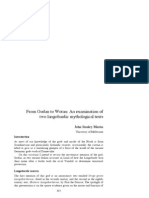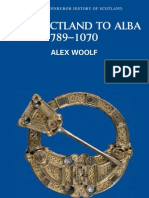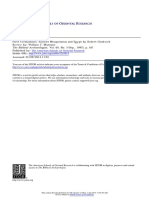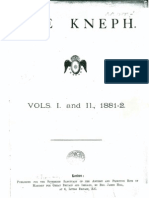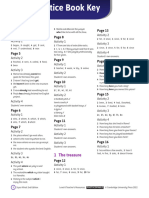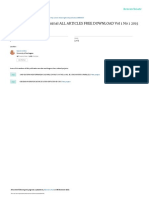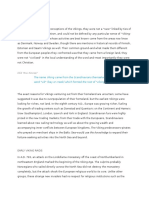0 ratings0% found this document useful (0 votes)
212 viewsIndo-Aryan and Slavic
Indo-Aryan and Slavic
Uploaded by
scridownloadThis document discusses linguistic similarities between Sanskrit and Slavic languages, particularly Slovenian. It begins by providing background on Sanskrit and its evolution from Vedic Sanskrit. It then notes that scholars have observed similarities between Sanskrit and classical European languages like Greek and Latin. The document goes on to describe specific grammatical similarities between Sanskrit and Slovenian in areas like phonology, morphology, syntax, and vocabulary. Examples are provided of similar words, cases, verb conjugations, and other linguistic structures. In summary, the document outlines the historical connections between Sanskrit and Slavic languages and provides evidence of the enduring linguistic affinities between Sanskrit and Slovenian.
Copyright:
© All Rights Reserved
Available Formats
Download as PDF, TXT or read online from Scribd
Indo-Aryan and Slavic
Indo-Aryan and Slavic
Uploaded by
scridownload0 ratings0% found this document useful (0 votes)
212 views8 pagesThis document discusses linguistic similarities between Sanskrit and Slavic languages, particularly Slovenian. It begins by providing background on Sanskrit and its evolution from Vedic Sanskrit. It then notes that scholars have observed similarities between Sanskrit and classical European languages like Greek and Latin. The document goes on to describe specific grammatical similarities between Sanskrit and Slovenian in areas like phonology, morphology, syntax, and vocabulary. Examples are provided of similar words, cases, verb conjugations, and other linguistic structures. In summary, the document outlines the historical connections between Sanskrit and Slavic languages and provides evidence of the enduring linguistic affinities between Sanskrit and Slovenian.
Copyright
© © All Rights Reserved
Available Formats
PDF, TXT or read online from Scribd
Share this document
Did you find this document useful?
Is this content inappropriate?
This document discusses linguistic similarities between Sanskrit and Slavic languages, particularly Slovenian. It begins by providing background on Sanskrit and its evolution from Vedic Sanskrit. It then notes that scholars have observed similarities between Sanskrit and classical European languages like Greek and Latin. The document goes on to describe specific grammatical similarities between Sanskrit and Slovenian in areas like phonology, morphology, syntax, and vocabulary. Examples are provided of similar words, cases, verb conjugations, and other linguistic structures. In summary, the document outlines the historical connections between Sanskrit and Slavic languages and provides evidence of the enduring linguistic affinities between Sanskrit and Slovenian.
Copyright:
© All Rights Reserved
Available Formats
Download as PDF, TXT or read online from Scribd
Download as pdf or txt
0 ratings0% found this document useful (0 votes)
212 views8 pagesIndo-Aryan and Slavic
Indo-Aryan and Slavic
Uploaded by
scridownloadThis document discusses linguistic similarities between Sanskrit and Slavic languages, particularly Slovenian. It begins by providing background on Sanskrit and its evolution from Vedic Sanskrit. It then notes that scholars have observed similarities between Sanskrit and classical European languages like Greek and Latin. The document goes on to describe specific grammatical similarities between Sanskrit and Slovenian in areas like phonology, morphology, syntax, and vocabulary. Examples are provided of similar words, cases, verb conjugations, and other linguistic structures. In summary, the document outlines the historical connections between Sanskrit and Slavic languages and provides evidence of the enduring linguistic affinities between Sanskrit and Slovenian.
Copyright:
© All Rights Reserved
Available Formats
Download as PDF, TXT or read online from Scribd
Download as pdf or txt
You are on page 1of 8
INDO-ARYAN AND SLAVIC AFFINITIES
Joseph Skulj, Jagdish C. Sharda
Hindu Institute of Learning, 11 Westacres Drive, Toronto Ontario, Canada, M6M-2B7
Introduction
The most important of the linguistic families of India, Pakistan and Ceylon (Sri Lanka) is the
Indo-Aryan, of which the ancient and classical form is Sanskrit. The word samskrta-means 'perfected',
'polished' and is strictly applied to the language as regulated and established by the Indian
grammarians. In a wider sense Sanskrit is applied both to the earlier form called Vedic Sanskrit which
appears in the Vedic texts and to the later form stereotyped by the grammarians (Panini) called
Classical Sanskrit. From Sanskrit are descended Pali and the various dialects of Prakrit, which are
collectively styled 'Middle Indo-Aryan'. Out of the Middle Indo-Aryan, the various modern Indo-
Aryan languages of the Indian area have evolved: Bengali, Hindi, Gujarati, Marathi, Punjabi etc.
Outside, Sanskrit is closely connected with the languages of the Iranian family of which the earliest
representatives are Avestan and Old Persian (Encyclopedia Americana).
The discovery of Sanskrit by European scholars towards the close of the 18th century was the
starting point of the scientific study of language. It was observed that in both vocabulary and grammar
Sanskrit was remarkably similar to the majority of the languages in Europe and particularly in
grammar, to the classical languages. The only theory that could explain these fundamental similarities
was that all the languages in question were derived from a common parent language (Encyclopedia
Americana).
Most scholars are cognizant of the similarities between Sanskrit and classical languages such as
Greek and Latin, but relatively few are aware that equal similarities still exist in modern, living Slavic
languages in particular Slovenian. Slovenian still preserves some grammatical forms that are no longer
present in other European or Indian languages.
Vedic and Classical Sanskrit
The language and literature of the Aryan invaders of India falls into two periods, the Vedic and
Sanskrit. Vedic is the English adjective formed from the noun veda, the native for the literature. The
word means "knowledge", (Slovenian "veda ") in the sense of sacred knowledge comparable to the
Bible. It is a religious literature, composed to meet the various needs of a complex religious system.
The four books of sacred writings are: Rig-Veda, Sama-Veda, Atharva-Veda and Yajur-Veda. The
oldest of these is Rig-Veda. The age estimates of Rig-Veda vary considerably between competent
scholars. They estimate the age anywhere from 3000 to 6000 years (Encyclopedia Americana).
The spoken dialect on which the language of the Rig-Veda is based lay to the northwest of the
area where the later classical language developed. The most important difference in the dialect
between Vedic and Classical Sanskrit lies in the treatment of Indo-European "r" and "l". In the Rig-
Veda, Indo-European "l" nearly always appears as "r", e.g. ruc 'light', (Slo. 'lu). In Classical Sanskrit,
on the other hand, "l" is frequently preserved, e.g. laghu 'light', (Slo. 'lahko'). Vedic, the earliest
literary language, was based on a dialect spoken in Punjab; the home of the Classical Sanskrit was the
ancient Madhyadesa or 'Middle Country', which corresponds roughly to the modern Uttar Pradesh.
Classical Sanskrit, which was eventually polished and fixed by Panini about 300 B.C., is essentially a
later form of the language that appears in the Vedas. The literary Sanskrit as the heir of the Vedic
religious tradition has remained down to the most recent times, the language of the traditional
Hinduism of India. The situation is similar to the position of Latin, which was the vehicle of the
classical and medieval culture of Europe and lived until recently in the writings and the liturgy of the
Catholic Church. With the aid of Panini's systematic grammar, an English judge in India Sir William
J ones announced in Calcutta-that Sanskrit, Greek and Latin "have sprung from some common source
which, perhaps, no longer exists." This was the seed from which sprang Indo-European comparative
grammar, the branch of linguistics that sets forth in all detail the relationship posited by J ones
(Emeneau M).
Linguistic Comparisons
Reindl (1999) gives an excellent short comparison between Sanskrit and Slovenian. Sanskrit and
Slovenian (and other Slavic languages) are related at the Indo-European level; that is, if you were to
think of the Slavic languages as being "sister" languages, Sanskrit would be a "cousin" language to
them.
Thus, there are certain similarities that can be observed in the areas of phonology, morphology,
syntax and lexicon because of their historical connection.
The phonological similarities are heightened by the fact that Slavic and Indic languages are both
part of the "satem" group of Indo-European languages; thus, they will often share an /s/, whereas other
languages will have a /k/, such as Germanic /h/. For example, Sanskrit satam 'hundred' and Slovenian
sto 'hundred', but Latin centum 'hundred' and German hundert 'hundred'.
Slavic is, very generally speaking, phonologically conservative in many ways, thus allowing us
to recognize cognates with Sanskrit because of its own archaic nature. For example, Sanskrit vranam
'wound' and Slovenian rana 'wound', Sanskrit maksha 'fly' and Slovenian muha 'fly', Sanskrit ish,
icchati 'to look for' and Slovenian iskati 'to look for'. (To Reindl's examples, it is possible to add many
others, such as Sanskrit mushka 'muscular person' and Slovenian moki 'manly', Sanskrit mush 'mouse'
and Slovenian mi 'mouse', Sanskrit i, eti 'to go' and Slovenian iti 'to go'.)
In the realm of morphology, Slovenian preserves the dual number (as does Sorbian, a Slavic
language spoken in eastern Germany). The verbal endings in the present tense are strikingly similar
between Slovenian and Sanskrit:
Singular Dual Plural
Skt patami patasi patati patava patathah patatah patamah patatha patanti
Slo padam pada pada padava padasta padata padamo padate padajo
Eng I fall you fall he falls we fall you fall they fall
Singular Dual Plural
Skt asmi asi asti svah sthah stah smah stha santi
Slo sem si je sva sta sta smo ste so
Hindi maim hum tu hai vah hai ham haim tum ho ve haim
Eng I am you are he is we are you are they are
Nouns also show similarities between Sanskrit and Slovenian. Both have dual. The vocative is not
preserved in Slovenian, but is found in Czech, Croatian, Serbian, Macedonian and Bulgarian. The full
8-case system of Sanskrit has evolved in most Slavic languages to 7 or 6 cases (Slovenian and Latin 6;
in Greek 5).
NUMERALS---CARDINALS:
ENGLISH SANSKRIT SLOVENIAN HINDI PUNJ ABI
one eka eden, neki 'someone' ek ek
two dva, f.dve dva, f.dve do do
three tri tri ti:n tinn
four catur tiri cha:r cha:r
five panca pet pa:nch panj
six shash, shat- est chhe chhe
seven sapta sedem sa:t satt
eight ashta: osem a:th atth
nine nava devet nau nau
ten das'a deset das das
(Macdonell)
decade das'at desetka dasshak
(Skt., peta 'open hand with fingers expanded' Slo., pedpet)
NUMERALS---ORDINALS:
ENGLISH SANSKRIT SLOVENIAN HINDI PUNJ ABI
first prathama(purva) prvi pehla pehla
second dvitiya drugi dusra duja
third tritiya tretji tisra tija
fourth caturtha etrti chautha chautha
fifth pancatha peti pachva pannava
sixth shashtha esti chhatha chhatha
seventh saptama sedmi satwa satma
eight ashtama osmi ath ath
ninth navama deveti navam nauvan
tenth das'ama deseti daswa daswa
twofold dvaya dvoje duguna duguna
threefold traya troje triguna triguna
tenfold dasa kritvas deset krat dasguna dasguna
(Macdonell)
Syntactically, most Slavic languages have adopted a basic SVO pattern, in distinction to the
(usual) SOV pattern in Sanskrit. Consideration that Sorbian is underlyingly OVS is questionable
(Reindl). Although Sanskrit SOV pattern is most frequent, the verb can occur anywhere in the
sentence (Venkatacharya).
In addition to noun declensions, Sanskrit grammar and Slovenian grammar have additional other
similarities. Both are highly inflected and have three genders - masculine, feminine and neuter. Both
have three numbers - singular, dual and plural; also adjectives are inflected to agree with the nouns.
Verbs are inflected for tense, mode, voice, number and person.
In Sanskrit only the first four numerals are declined in three genders. The numerals 1, 2, 3 and 4
agree in gender and case with the following noun. (This is similar to Slovenian.) The numerals from 5
to 19 are declined alike in the three genders. They agree with the nouns they qualify in gender, number
and case. (In Slo., they agree in number and case, but not in gender.)
In Sanskrit and Slovenian, the ordinals, being all adjectives, are all declined in masculine,
feminine and neuter. They agree in gender, number and case with the following nouns.
Additional Vocabulary Comparisons
The Sanskrit vocabulary can be found in Sir Monier Monier-Williams A Sanskrit-English
Dictionary, and SED column indicates the page numbers, where additional meanings can be found.
Nouns and adjectives are presented as roots without nominative endings. Verbs are also rendered in a
root form plus 3rd person singular or 3rd person singular ending.
SANSKRIT SED ENGLISH SLO. HINDI PUNJ ABI
ad 17 eating jed adna: adna:
agni 5 fire ogenj a:g, agni agg
ajijivat, cf. jiv 422 restore to life oiveti
agnishtha 5 fire-pan ognjie
apuplavat,cf.plu715 to inundate, submerge poplaviti aplavit karana:
akarna 1 without ears okrnjen
aru, arauti 150 to shout, cry towards rjuti rona: rona:
aruj, arujati 150 to tear out, demolish ruiti, ruvati
askand, -ati 161 to invade, assault naskoiti
asku, askauti 161 to pluck, tear, pull oskubiti
asu, asuvati 160 send off towards suvati
aushta 240 lip-shaped usta oth hoth
aruna 88 redish brown, red rujno arun arun
badisa, vadisa 719 hook, fish-hook bodica
bal, balate 722 to hurt, to mention boleti
bala 722 young shoot bil bel vel
bala 722 sick bolan
bhaga 743 gracious lord (gods) bog bhagwa:n
bhagavat 743 prosperous bogat bhagavat
bhara 747 gain, prize, booty bera bha:r bharr
bhara, bharat 747 shout barati bha:r 'force' bha:r force'
bharts, -ayati 748 to abuse, menace brcati
bhiyas 758 fear, apprehension bojazen bhaya bhaya
bhiyasana 758 fearful, timid bojazen,-ljiv bhi:shan bhi:shan
bhlas', -ate 771 to shine, glitter bleati
bhratri 770 brother brat bhra:ta: ?
bhru 770 the brow obrv bhru:
bhu, bhavati 760 to exist, live, abide bivati
bhuta 761 being, existing biti bhav
bhugna 750 bent, curved, cowed upognjen jhukna: jhukna:
bhur, bhurati 760 to stir, palpitate buriti
bhurloka 763 world, earth brlog 'den' bhu:lol bhuin
bija/vija 732 origin of poem via bi:j bi:
bil/vil, bilati 732 to split, cleave vile 'forks'
bis', bes'ati 732 to go beati 'flee'
bis, bisyati 732 to urge on, incite bezati
brinh, -ayati 735 to further, promote brigati se
bru, braviti 742 to speak, say, tell praviti
budh, bodhati 733 to wake, wake up buditi bodha mem rahna:
buddha 733 awakened buden
budhna 735 bottom, ground poden
etc.
Names
In addition to grammatical and linguistic affinities between Indo-Aryan languages and Slavic
languages in particular Slovenian, there are also some similarities in the Slovenian family names and
names found on the Indian sub-continent.
HINDU NAMES MEANING SLO. NAMES
A:pi friend, ally, acquaintance Apih
Apa:ra: boundless, with no rival, unequalled Opara
Archana: respected Aran, Aron
Archin shining, devout Arin
Arha deserving Arh
Ariha killing enemies Arih
Arjuna white, clear, fair in visage and mind Eren
Arka ray, learned man, (Skt. singer) Arko
As'mana stone, gem, thunderbolt Aman
As'na: eating a lot, voracious Anik
avasanika (Skt) being at the end Avsenek
Bahula broad, ample, large, abundant Pahulje
Bachil (Skt vacana) one who speaks much, orator Banik
Bahuvata strong-armed Bahovec
baida/vaida(Skt) wise man, learned Bajda/Vajda
Bhanu light, glory, king, master Ban
bharaga(Skt) going under load Baraga
Bharu bearing a load, lord, master Bari
bhasaya(Skt) to resemble a bird Basaj
bhela(Skt) timid, ignorant, foolish Belej
balihara(Skt) paying tribute, taxes Belihar
Bhanga to break, destroy, destroyer Benko
Bharanyu striving to fulfil, protector, master, friend Beranek
bhruna(Skt) child, boy Bruni
Bukka: the heart, loving, sincere Buko-vec
Etc.
(Gandhi) (T. I. S.)
Note: For Sanskrit transliteration, Monier-Williams' A Sanskrit-English Dictionary convention, where
possible, was followed, but long and short vowels are not indicated. The pronunciation is similar to
English, but C is pronounced as CH and S' as SH. For Hindi and Punjabi, Chaturvedi and Tiwari's A
Practical Hindi-English transliteration was followed. The pronunciation is similar to English and :
denotes a long vowel. For Slovenian is pronounced as CH, J as Y, as SH and as J in French.
Numerical Comparisons
An attempt was made to determine, on a percentage basis, how many cognate words Vedic
Sanskrit and Classical Sanskrit share with Slovenian. To compare Vedic Sanskrit with Slovenian, the
vocabulary of Macdonell's A Vedic Reader for Students was used. All entries were compared, except
names and derivatives for a total of 1612. Out of 1612, some 330 were similar to Slovenian in sound
and meaning. This is 20.5%. For Classical Sanskrit comparison, Sanskrita Jnana-Jyotih textbooks 1
and 2 were used. The vocabulary consists of 735 words, where 74 were similar to Slovenian for a 10%
similarity.
Some additional NUMERICAL COMPARISONS of similarities (%) with Slovenian:
Language Similar. Remark
Russian ~80
Vedic Sanskrit ~20
Classical Sanskrit ~10
Lithuanian ~10
German ~6 Half of these are technical terms such as anode, seminar, selenium, etc.
Irish Gaelic ~3 A third of these are technical and trade names, e.g. doctor, captain, etc.
Latin ~2
Persian ~1
Divergence of Sanskrit and Slovenian
Despite of numerous similarities in the two languages, there is no common recognizable
terminology for metals. The discovery and dating of the 'Ice Man' in the South Tyrol with his copper
axe, indicates that metals were known 5,200 years ago. This could be construed that the two languages
separated before metallurgy became known.
Genetic Affinities
Barbujani (1997) agrees with other authors such as Renfrew and Guglielmino who see linguistic
affinities as clues to population history. He cites Sokal who wrote, that a common language frequently
reflects a common origin, and a related language indicates a common origin too, but farther back in
time. He also makes an observation, that the partial correlations with language are stronger for Y
chromosomes than for mtDNA. This suggests that when women were incorporated into a group
speaking a different language, they passed to the future generations, along with their own genes, their
husbands' language.
Kivisild et al. (1999) in their analyses of Indian and western-Eurasian mtDNA lineages (Czechs,
Slovaks and Russians included), found an extensive deep late Pleistocene (51,000-67,000 BP) link
between contemporary Europeans and Indians provided by the mtDNA haplogroup U. This probably
predates their spread to Europe. Only a small fraction of the 'Caucasoid-specific' mtDNA lineages
found in Indian populations can be ascribed to a relatively recent admixture, which they date at
9,300+- 3,000 BP and also conclude that this does not support a recent massive Indo-Aryan invasion,
at least as far as far as maternally inherited genetic-lineages are concerned.
Malaspina et al. (2000) have analyzed the Y chromosome in various populations and have broken
it down into networks such as 1.1, 1.2, 1.3, 2.1, 3.1G, 3.1A, 1.4 and others. They conclude that 1.1,
2.1, and 3.1G coalesce in the Paleolithic. Underhill et al. (2000) date the expansion of humans out of
Africa a ~45,000 BP. The following is the indicated presence in some Indo-Aryan, Dravidic and
Slavic populations:
Y chrom. network. 1.1 2.1 3.1G Total
Brahui 0.20 0 0.07 0.27
Punjabi 0.23 0 0.15 0.38
Sindhi 0.30 0.05 0.15 0.50
Slovak 0.43 0.09 0 0.52
Ukrainian 0.33 0.17 0 0.50
Polish 0.31 0.03 0.19 0.52
Two networks 1.2 and 3.1A coalesce in a window of time post-dating Last Glacial Maximum (ca.
20,000 BP):
Y chrom. network. 1.2 3.1A Total
Brahui 0.27 0.33 0.60
Punjabi 0 0.46 0.60
Sindhi 0.05 0.35 0.40
Slovak 0 0.39 0.39
Ukrainian 0 0.50 0.50
Polish 0.06 0.39 0.45
Network 3.1A clearly discriminates between Western and Eastern European (and Indian)
populations (Malaspina et al.). In Portugal and Central Spain it is not found; in Southern Spain it is
present at .02 level. On the Italian peninsula, it is present at .10 in Apulia and Venetia. East of Italian
peninsula, the presence increases and is present at higher levels (~.45) in Central and Eastern Europe
and also on the Indian sub-continent (~.38) level.
Network 1.3, which dates back to the last 3,000-4,000 BP, is common in Sardinians, but is not
present in Indians or Slavs.
Dating of Migrations
Based on mt DNA sequences in ancient Australians, Adcock et al. (2001) see evidence that, there
is morphological evidence for the survival of Neanderthal genes in Europe after the arrival of Cro
Magnon people. Underhill et al. (2001), suggest that modern humans dispersed across Africa and into
Western Asia, Asia and Melasia and then into Northern Eurasia. Overlain on these events are the
contractions with the Last Glacial Maximum (LGM), and subsequent post-glacial expansion of both
hunter-gatherers and agriculturists. Underhill et al. (2000) sees evidence that small sub-group of
humans separated into several fairly isolated groups. These groups remained small throughout the last
glaciation before they underwent roughly simultaneous expansion in size.
Richards et al. (2000) used founder analysis method for analysis of nonrecombining DNA
sequence data, with the aim of identification and dating of migrations into new territory. They
conclude that:
(i) There has been substantial back-migration into the Near East,
(ii) The majority of extant mt DNA lineages entered Europe in several waves during the Upper
Paleolithic (ca. 45,000 BP),
(iii) There was a founder effect or bottleneck associated with the Last Glacial Maximum, 20,000
years ago, from which derives the largest fraction of surviving lineages, and
(iv) The immigrant Neolithic (ca. 9,000 BP) component is likely to comprise less than one-quarter
of the mtDNA pool of modern Europeans.
Richards et al. (2000) using mtDNA trace lineages back into prehistory, through the Last Glacial
Maximum (LGM), to the first settlement of Europe by anatomically modern humans, almost 50,000
BP. They have found that, the first four migrations from 45,000- 9,000 BP brought over 90% of the
genes to Europe and that, less than 10% of the population came to the present regions in the last 3,000
years - Alps 6.9%, South-eastern Europe 8.2%, and North-eastern Europe 5.5%.
Based on linguistic and genetic information, tih (2000) appears to be correct in his assertion that
all those presentations and assertions bespeaking the settlement of the Slovenes in the eastern Alpine
region at the end of 6th century are a historical myth.
References
Antoine R, A Sanskrit Manual 13th ed., Xavier Publications, Calcutta, India 1991, pp.117-121.
Barbujani G, (1997) DNA Variation and Language Affinities. Am. J. Hum. Genet. 61:1011-1014.
Emeneau MB, "Sanskrit". Encyclopedia Americana, 2000, 24:232-233.
Gandhi M, Book of Hindu Names. Penguin Books, New Delhi, India 1993, pp.1-79.
Lakshminarayana S, Sanskrita Jnana-Jotih, Book 1 and 2, Arya Buk Dipo, New Delhi, India 1997.
Malaspina P, et al. (2000) Patterns of male-specific inter-population divergence in Europe, West Asia and North
Africa. Ann. Hum. Genet. 64:395-412.
Macdonell AA, A Vedic Grammar for Students, 2nd ed. Motilal Barnasidass Publishers Private Limited, Delhi,
India 1995, pp.96-103.
Macdonell AA, A Vedic Reader for Students, 2nd ed. Low Price Publications, Delhi, India 1995, pp. 221-263
Monier-Williams M, A Sanskrit Dictionary, 12th ed. Motilal Barnasidass Publishers Private Limited, Delhi,
India 1993.
Reindl DF, (Information in an e-mail from Professor Donald F. Reindl, Department of Slavic Languages and
Literatures, Indiana University, 09/04/99).
tih Peter, "Autochthonal Theories Among The Slovenes" (Paper presented at annual gathering of American
Association for the Advancement of Slavic Studies Nov. 12, 2000, Denver, Colorado, U. of Ljubljana,
Slovenia).
T.I.S., Telefonski Imenik Slovenije
Underhill PA, et al.(2000) Y chromosome sequence variation and the history of human populations. Nature
Genetics 26:358-361.
Undehill PA et al. (2001) The phylogeography of Y chromosome binary haplotypes and the origins of modern
humans. Ann. Hum. Genet. 65:43-62.
Venkatacharya HA, (Personal communication from Professor H .A.Venkatacharya, Professor Emeritus of
Sanskrit, University of Toronto).
Williams M, A Dictionary English & Sanskrit, 4th ed. Motilal Barnasidass, Delhi, India 1982, pp. 1-859.
Abstract
Languages have a great evolutionary significance, because linguistic affinities are also clues to population
history. A common language frequently reflects a common origin, and a related language indicates a common
origin too, but further back in time (Barbujani 1997). Comparison of Sanskrit and modern Indian languages
Hindi and Punjabi with Slovenian belonging to a Slavic language family shows that there is a linguistic
similarity and the older the language the greater is the resemblance. Sanskrit, especially Vedic Sanskrit, which is
the oldest, exhibits more similarities to Slovenian than Hindi or Punjabi. A statistical comparison shows
that~20% of Vedic words are same or similar to Slovenian in sound and meaning. Similar comparison with the
Classical Sanskrit, shows ~10% similarity. This resemblance is not limited to linguistics, but can be further seen
in some family and also some topographical names. This can be taken as indication that Slovenian language has
changed relatively slowly over the millennia. Within this context, it would be reasonable to expect, that a
modern Slovenian, familiar with the dialects and other Slavic languages, should be able to recognize words and
meanings of the Venetic language, if it belongs to the same language family. In addition to linguistics, there are
also genetic similarities between Slavs of Europe and the peoples of the Indian sub-continent.
Povzetek
J eziki imajo velik pomen pri ugotavljanju razvoja, saj so jezikovne podobnosti lahko klju do zgodovine
ljudstev. Podoben jezik pogosto kae na skupen izvor in sorodni jeziki tudi kaejo na skupen izvor, vendar dlje v
preteklosti (Barbujani 1997). Primerjava sanskrta in sedanjih indijskih jezikov hindija in pandabija s
slovenskim, ki pripada slovanski skupini, kae podobnosti in im stareji je jezik, tem ve jih je. Sanskrt,
posebno vedski sanskrt, ki je najstareji, kae ve podobnosti s slovenskim jezikom kot hindi ali pandabi.
Statistina primerjava kae, da je okoli 20% vedskih besed enakih ali podobnih slovenskim v zvenu in pomenu.
Za klasini sanskrt je podobnosti okoli 10%. Ta podobnost ni omejena na jezikoslovje, temve je opazna tudi pri
nekaterih druinskih in topografskih imenih. To nam nakazuje, da se je slovenina v zadnjih tisoletjih le poasi
spreminjala. Glede na to bi lahko priakovali, da bi sedanji Slovenec, ki pozna nareja in druge slovanske jezike,
lahko prepoznal besede in pomene venetskega jezika, e ta spada v isto jezikovno skupino. Poleg jezikovnih
obstajajo tudi genetske podobnosti med Slovani v Evropi in ljudmi v Indiji.
You might also like
- Ryholt 2004 - The Assyrian Invasion of Egypt in Egyptian Literary Tradition (Fs Larsen) .Pdf20131231-38847-3vhqk0-Libre-Libre PDFDocument29 pagesRyholt 2004 - The Assyrian Invasion of Egypt in Egyptian Literary Tradition (Fs Larsen) .Pdf20131231-38847-3vhqk0-Libre-Libre PDFJordi Teixidor AbelendaNo ratings yet
- Sanskrit and The Serbian SlavsDocument4 pagesSanskrit and The Serbian SlavsAndras VargaNo ratings yet
- Mythology of Bosnia and HerzegovinaDocument29 pagesMythology of Bosnia and Herzegovinazemerijas100% (3)
- Darius' Bisitun Inscription, Babylonian VersionDocument11 pagesDarius' Bisitun Inscription, Babylonian Versionمرتزآ بهرامی100% (1)
- Jelena Marohnić-Diomedove PticeDocument21 pagesJelena Marohnić-Diomedove PticefreiheitssucherNo ratings yet
- India Russia Rishi OCRDocument31 pagesIndia Russia Rishi OCRIreneoNo ratings yet
- Staroverstvo - The Old Religion - The Slovene PreDocument8 pagesStaroverstvo - The Old Religion - The Slovene PrebrinjevecNo ratings yet
- Srbi KeltiDocument9 pagesSrbi Keltisteve alexNo ratings yet
- Sanskrit and The Serbian SlavsDocument6 pagesSanskrit and The Serbian SlavsZvonimir JancicNo ratings yet
- Srdjan Radovic - Beogradski OdonimiDocument188 pagesSrdjan Radovic - Beogradski OdonimiakunjinNo ratings yet
- The River in The Mythical and Religious Traditions of The Paeonians - Nikos ČausidisDocument23 pagesThe River in The Mythical and Religious Traditions of The Paeonians - Nikos ČausidisSonjce Marceva100% (1)
- Studies in Yama and MāraDocument20 pagesStudies in Yama and Māracha072No ratings yet
- Rečnih Starih Izumrlih JezikaDocument146 pagesRečnih Starih Izumrlih JezikashargaNo ratings yet
- Earliest Slavic PoemDocument13 pagesEarliest Slavic PoemAlex ForemanNo ratings yet
- Faked History of Kapllani, Academic From UlqiniDocument1 pageFaked History of Kapllani, Academic From UlqiniKlavio DevilhaterNo ratings yet
- Slavic Influences in Ancient GaulDocument11 pagesSlavic Influences in Ancient GaulSlovenianStudyReferencesNo ratings yet
- Proto Slavic AccentDocument4 pagesProto Slavic AccentOmar KhayyamNo ratings yet
- Traces of Vit, Rod and ChrodoDocument16 pagesTraces of Vit, Rod and ChrodoRichter, JoannesNo ratings yet
- New Reading of The Thracian Inscription On The Golden Ring From EzerovoDocument8 pagesNew Reading of The Thracian Inscription On The Golden Ring From EzerovoAnomijaNo ratings yet
- The Impact of Islam and Sufism On The Monotheistic Bhakti MovementDocument12 pagesThe Impact of Islam and Sufism On The Monotheistic Bhakti Movementsantosh kumarNo ratings yet
- Henning, First Indo-EuropeanDocument16 pagesHenning, First Indo-EuropeanCyrus NasrollahzadehNo ratings yet
- TH e Origins of Sventovit of Rügen: Roman ZaroffDocument10 pagesTH e Origins of Sventovit of Rügen: Roman ZaroffSTNo ratings yet
- The Pre-Indo-European Issue Revisited. TDocument11 pagesThe Pre-Indo-European Issue Revisited. TtomacsaNo ratings yet
- History of Medieval Croatia 2018Document1 pageHistory of Medieval Croatia 2018houzindek100% (1)
- LOOIJENGA Texts and Contexts of The Oldest Runic Inscriptions 2003Document377 pagesLOOIJENGA Texts and Contexts of The Oldest Runic Inscriptions 2003No ThankyouNo ratings yet
- Mithraism in The Territory of Today's Herzegovina (Članak) PDFDocument16 pagesMithraism in The Territory of Today's Herzegovina (Članak) PDFAmra Šačić Beća100% (1)
- 2 - South Slavs and The Balkan NativesDocument8 pages2 - South Slavs and The Balkan NativesMilan JovanovićNo ratings yet
- The Invention of The Slavic FairytaleDocument10 pagesThe Invention of The Slavic FairytaleBasil Chulev100% (1)
- Slavs AdriaticDocument0 pagesSlavs Adriatict3klaNo ratings yet
- Jay Jasanoff, The Prehistory of The Balto-Slavic AccentDocument285 pagesJay Jasanoff, The Prehistory of The Balto-Slavic AccentGuldre1okk100% (1)
- Detelic-The Magical and Aesthetic in The Folklore of Balkan SlavsDocument7 pagesDetelic-The Magical and Aesthetic in The Folklore of Balkan Slavsivana_82No ratings yet
- Etymologica Et Anthropologica MaioraDocument382 pagesEtymologica Et Anthropologica MaioraSorin PaligaNo ratings yet
- Milich P., Slavic EthnogenesisDocument12 pagesMilich P., Slavic Ethnogenesisneven81No ratings yet
- Damir Saciragic - Bono HominiDocument56 pagesDamir Saciragic - Bono HominiStela Kalli Solare100% (2)
- Godisnjak42 Full PDFDocument247 pagesGodisnjak42 Full PDFdzemalsabicNo ratings yet
- Indo-Aryan and Slavic Linguistic Affinities...Document35 pagesIndo-Aryan and Slavic Linguistic Affinities...SlovenianStudyReferences100% (41)
- A.vukmanovic Svadbeni Kod U BasmamaDocument14 pagesA.vukmanovic Svadbeni Kod U BasmamaakunjinNo ratings yet
- A.H.Wratislaw Sixty Folk Tales From Slavonic SourcesDocument327 pagesA.H.Wratislaw Sixty Folk Tales From Slavonic SourcesPilipendaRistov100% (2)
- The Tribes of Albania History Society and Culture 9780755621767 9781784534011Document375 pagesThe Tribes of Albania History Society and Culture 9780755621767 9781784534011kolasinarsaNo ratings yet
- The Ancient Illyrians-Bosnia and HerzegovinaDocument13 pagesThe Ancient Illyrians-Bosnia and Herzegovinazemerijas100% (1)
- Greece KingdomsDocument23 pagesGreece Kingdomsuday100% (1)
- BactriaDocument12 pagesBactriaanna shuklaNo ratings yet
- Karloff We Made Music in Hell Essay FinalDocument26 pagesKarloff We Made Music in Hell Essay Finalapi-519546062No ratings yet
- Cirkovic S., Stare I Nove Kontroverze o Knezu Lazaru I Srbiji Uoci Kosovske BitkeDocument7 pagesCirkovic S., Stare I Nove Kontroverze o Knezu Lazaru I Srbiji Uoci Kosovske Bitkeneven81100% (2)
- Origin of Yuezhi TribeDocument23 pagesOrigin of Yuezhi Tribeplast_adeshNo ratings yet
- Slavs in Antiquity - Valentin VDocument2 pagesSlavs in Antiquity - Valentin VJelena JovanovićNo ratings yet
- EtruscaniDocument27 pagesEtruscanitrornNo ratings yet
- ''Abkhaz Personal Names'' PDFDocument20 pages''Abkhaz Personal Names'' PDFThriwNo ratings yet
- The Aryan Hypothesis and Indian IdentityDocument12 pagesThe Aryan Hypothesis and Indian IdentitymariaaliciafarainNo ratings yet
- The Home of The Aryans: UZ Mina HishlinaDocument53 pagesThe Home of The Aryans: UZ Mina HishlinaRo LuNo ratings yet
- Macedonia-Aryan Ancestral Homeland. A.A.klyosov: Where The "Slovens" and "Indo-Europeans" Came From? The DNA-Genealogy Provides The Answer.Document29 pagesMacedonia-Aryan Ancestral Homeland. A.A.klyosov: Where The "Slovens" and "Indo-Europeans" Came From? The DNA-Genealogy Provides The Answer.Basil ChulevNo ratings yet
- Evidence For The Slavic Homeland in The Middle Dnieper Basin (Journal of Human Genetics)Document9 pagesEvidence For The Slavic Homeland in The Middle Dnieper Basin (Journal of Human Genetics)Macedonia - The Authentic TruthNo ratings yet
- Romani Narratives About Pre Death DeathDocument336 pagesRomani Narratives About Pre Death Deathpenn hicksNo ratings yet
- 3121 6442 1 SP PDFDocument20 pages3121 6442 1 SP PDFMusa DoğanNo ratings yet
- On the Track of the Sun – The Red Warriors from Chorasmia: CHORASMIAFrom EverandOn the Track of the Sun – The Red Warriors from Chorasmia: CHORASMIANo ratings yet
- Charismatic Leadership in Islam: The Powerful Position of Sufi Shaikhs in BosniaFrom EverandCharismatic Leadership in Islam: The Powerful Position of Sufi Shaikhs in BosniaNo ratings yet
- The Early Modern Travels of Manchu: A Script and Its Study in East Asia and EuropeFrom EverandThe Early Modern Travels of Manchu: A Script and Its Study in East Asia and EuropeNo ratings yet
- Linguistics57 - This Book Is Intended To Be An Introduction To The Grammatical Structure of TheDocument2 pagesLinguistics57 - This Book Is Intended To Be An Introduction To The Grammatical Structure of ThescridownloadNo ratings yet
- Bomhard - An Introductory Grammar of The Pali LanguageDocument143 pagesBomhard - An Introductory Grammar of The Pali LanguageAllan Bomhard100% (2)
- Sanskrit StudiesDocument53 pagesSanskrit StudiesscridownloadNo ratings yet
- BuddhismDocument10 pagesBuddhismscridownloadNo ratings yet
- Study Guide Skt102bDocument3 pagesStudy Guide Skt102bscridownloadNo ratings yet
- Booklist Sanskrit For BeginnersDocument2 pagesBooklist Sanskrit For BeginnersscridownloadNo ratings yet
- DU Pali SyllabusDocument3 pagesDU Pali SyllabusscridownloadNo ratings yet
- Nárada's Pali Course 2008Document53 pagesNárada's Pali Course 2008lengcaiNo ratings yet
- Buy Ebook The Oxford Handbook of Archaeological Ceramic Analysis (Oxford Handbooks) 1st Edition Alice M. W Hunt (Editor) Cheap PriceDocument52 pagesBuy Ebook The Oxford Handbook of Archaeological Ceramic Analysis (Oxford Handbooks) 1st Edition Alice M. W Hunt (Editor) Cheap Priceteftacateau100% (5)
- Tabon ManDocument3 pagesTabon Manarchie demesaNo ratings yet
- Lesson 7: Art in Early CivilizationsDocument12 pagesLesson 7: Art in Early Civilizationsmel0nNo ratings yet
- Hadrians BathsDocument14 pagesHadrians BathsSoma QueenNo ratings yet
- World Religions - From Ancient History To The PresentDocument532 pagesWorld Religions - From Ancient History To The PresentLjubica Obradovic100% (1)
- Ancient CarthageDocument7 pagesAncient Carthagejuansinn2924No ratings yet
- Year Three - Ancient Civilizations - Sequence TwoDocument7 pagesYear Three - Ancient Civilizations - Sequence TwoRabie CordobaNo ratings yet
- John Stanley Martin - From Godan To WotanDocument13 pagesJohn Stanley Martin - From Godan To WotanΘοδωρής Κύ100% (1)
- The Decline of The Cow: Agricultural and Settlement Change in Early Medieval IrelandDocument16 pagesThe Decline of The Cow: Agricultural and Settlement Change in Early Medieval IrelandoldenglishblogNo ratings yet
- Woolf, Alex - From Pictland To Alba Scotland, 789-1070Document401 pagesWoolf, Alex - From Pictland To Alba Scotland, 789-1070Phone It In100% (3)
- India's Legendary Wootz SteelDocument153 pagesIndia's Legendary Wootz SteelCesare Battistotti100% (1)
- The American Schools of Oriental ResearchDocument2 pagesThe American Schools of Oriental ResearchLuke HanscomNo ratings yet
- Dredged Up: Book Your Protocol Awareness Visit Today Email Us at Protocol@wessexarch - Co.uk or Call Us On 01722 326867Document8 pagesDredged Up: Book Your Protocol Awareness Visit Today Email Us at Protocol@wessexarch - Co.uk or Call Us On 01722 326867Wessex ArchaeologyNo ratings yet
- Get A House With Good Bones 1st Edition T Kingfisher Free All ChaptersDocument49 pagesGet A House With Good Bones 1st Edition T Kingfisher Free All Chaptersmcgrewrerrie100% (6)
- 1lonbon: Ron O) ' 6, E.CDocument12 pages1lonbon: Ron O) ' 6, E.CBen WattNo ratings yet
- 332: Castle Mews, Caerleon, Newport, Watching Brief, APAC LTDDocument99 pages332: Castle Mews, Caerleon, Newport, Watching Brief, APAC LTDAPAC LtdNo ratings yet
- Nyame Akuma Issue 061Document78 pagesNyame Akuma Issue 061Barima BasoaNo ratings yet
- Super Mind Practice Book L6 Answer Key.Document6 pagesSuper Mind Practice Book L6 Answer Key.christalNo ratings yet
- The Rebirth of Towns in The West AD 700-1050Document144 pagesThe Rebirth of Towns in The West AD 700-1050carlazNo ratings yet
- Death of The Iceman - OdtDocument2 pagesDeath of The Iceman - OdtMulholland Váradi EszterNo ratings yet
- Content and Contextual Analysis of Selected Primary SourcesDocument11 pagesContent and Contextual Analysis of Selected Primary SourcesJoshua GalvezNo ratings yet
- Courtly Art of The Ancient MayaDocument16 pagesCourtly Art of The Ancient MayaAni Thomas100% (3)
- Scientific Culture Journal All Articles Free Download Vol 1 No 1 2015Document51 pagesScientific Culture Journal All Articles Free Download Vol 1 No 1 2015Mohamed Amine MajdoubNo ratings yet
- Unit Four Review Guide: Art in The Ancient Mediterranean. AP Art History, Spring 2017Document3 pagesUnit Four Review Guide: Art in The Ancient Mediterranean. AP Art History, Spring 2017young kimNo ratings yet
- 2122 HTS1 A Survey of Architecture and Urban History Term 1 - Aryan Sarode 80219Document9 pages2122 HTS1 A Survey of Architecture and Urban History Term 1 - Aryan Sarode 80219aryanNo ratings yet
- A026 ST - Com SM2012Document63 pagesA026 ST - Com SM2012Zorana DimkovićNo ratings yet
- History OGP MCQDocument213 pagesHistory OGP MCQsakjdhas100% (1)
- Who Were The VikingsDocument22 pagesWho Were The VikingsanshuagrahariNo ratings yet

